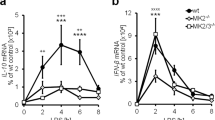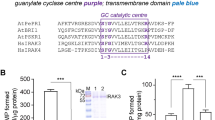Abstract
MAPKAP kinase 2 (MK2) is one of several kinases that are regulated through direct phosphorylation by p38 MAP kinase. By introducing a targeted mutation into the mouse MK2 gene, we have determined the physiological function of MK2 in vivo. Mice that lack MK2 show increased stress resistance and survive LPS-induced endotoxic shock. This is due to a reduction of ∼90 % in the production of tumor necrosis factor-α (TNF-α) and not to a change in signalling from the TNF receptor. The level and stability of TNF-α mRNA is not reduced and TNF-α secretion is not affected. We conclude that MK2 is an essential component in the inflammatory response which regulates biosynthesis of TNF-α at a post-transcriptional level.
This is a preview of subscription content, access via your institution
Access options
Subscribe to this journal
Receive 12 print issues and online access
$209.00 per year
only $17.42 per issue
Buy this article
- Purchase on Springer Link
- Instant access to full article PDF
Prices may be subject to local taxes which are calculated during checkout




Similar content being viewed by others
References
Rouse, J. et al. A novel kinase cascade triggered by stress and heat shock that stimulates MAPKAP kinase-2 and phosphorylation of the small heat shock proteins . Cell 78, 1027–1037 (1994).
Freshney, N. W. et al. Interleukin-1 activates a novel protein kinase cascade that results in the phosphorylation of Hsp27. Cell 78, 1039–1049 (1994).
Han, J., Lee, J. D., Bibbs, L. & Ulevitch, R. J. A MAP kinase targeted by endotoxin and hyperosmolarity in mammalian cells. Science 265, 808–811 ( 1994).
Raingeaud, J., Whitmarsh, A. J., Barrett, T., Derijard, B. & Davis, R. J. MKK3- and MKK6-regulated gene expression is mediated by the p38 mitogen-activated protein kinase signal transduction pathway. Mol. Cell. Biol. 16, 1247– 1255 (1996).
Wang, X. et al. The phosphorylation of eukaryotic initiation factor eIF4E in response to phorbol esters, cell stresses, and cytokines is mediated by distinct MAP kinase pathways. J. Biol. Chem. 273, 9373 –9377 (1998).
Xia, Z., Dickens, M., Raingeaud, J., Davis, R. J. & Greenberg, M. E. Opposing effects of ERK and JNK-p38 MAP kinases on apoptosis. Science 270, 1326–1331 (1995).
Takenaka, K., Moriguchi, T. & Nishida, E. Activation of the protein kinase p38 in the spindle assembly checkpoint and mitotic arrest. Science 280 , 599–602 (1998).
Lee, J.C. et al. A protein kinase involved in the regulation of inflammatory cytokine biosynthesis. Nature 372, 739– 746 (1994).
Simon, C., Goepfert, H. & Boyd, D. Inhibition of the p38 mitogen-activated protein kinase by SB203580 blocks PMA-induced Mr 92,000 type IV collagenase secretion and in vitro invasion. Cancer Res. 58, 1135– 1139 (1998).
Lee, J.C. et al. Bicyclic imidazoles as a novel class of cytokine biosynthesis inhibitors. Ann. N.Y. Acad. Sci. 696, 149 –170 (1993).
Rincon, M. et al. The JNK pathway regulates the in vivo deletion of immature CD4(+)CD8(+) thymocytes. J. Exp. Med. 188, 1817–3011.
Stokoe, D. et al. MAPKAP kinase-2; a novel protein kinase activated by mitogen-activated protein kinase. EMBO J. 11, 3985– 3994 (1992).
Sithanandam, G. et al. 3pK, a new mitogen-activated protein kinase-activated protein kinase located in the small cell lung cancer tumor suppressor gene. Mol. Cell. Biol. 16, 868–876 (1996).
Fukunaga, R. & Hunter, T. MNK1, a new MAP kinase-activated protein kinase, isolated by a novel expression screening method for identifying protein kinase substrates. EMBO J. 16, 1921 –1933 (1997).
Waskiewicz, A. J., Flynn, A., Proud, C. G. & Cooper, J. A. Mitogen-activated protein kinases activate the serine/threonine kinases Mnk1 and Mnk2. EMBO J. 16, 1909–1920 ( 1997).
New, L. et al. PRAK, a novel protein kinase regulated by the p38 MAP kinase. EMBO J. 17, 3372–3384 ( 1998).
Deak, M., Clifton, A. D., Lucocq, J. M. & Alessi, D. R. Mitogen- and stress-activated protein kinase-1 (MSK1) is directly activated by MAPK and SAPK2/p38, and may mediate activation of CREB. EMBO J. 17, 4426–4441 ( 1998).
Jiang, Y. et al. Characterization of the structure and function of a new mitogen-activated protein kinase (p38beta). J. Biol. Chem. 271, 17920–17926 (1996).
Wang, X. Z. & Ron, D. Stress-induced phosphorylation and activation of the transcription factor CHOP (GADD153) by p38 MAP kinase. Science 272, 1347–1349 ( 1996).
Han, J., Jiang, Y., Li, Z., Kravchenko, V. V. & Ulevitch, R. J. Activation of the transcription factor MEF2C by the MAP kinase p38 in inflammation. Nature 386, 296–299 (1997).
Stokoe, D., Engel, K., Campbell, D. G., Cohen, P. & Gaestel, M. Identification of MAPKAP kinase 2 as a major enzyme responsible for the phosphorylation of the small mammalian heat shock proteins. FEBS Lett. 313, 307–313 (1992).
Cano, E., Doza, Y. N., Ben-Levy, R., Cohen, P. & Mahadevan, L. C. Identification of anisomycin-activated kinases p45 and p55 in murine cells as MAPKAP kinase-2. Oncogene 12, 805–812 ( 1996).
Galanos, C., Freudenberg, M. A. & Reutter, W. Galactosamine-induced sensitization to the lethal effects of endotoxin. Proc. Natl Acad. Sci. USA 76, 5939–5943 (1979).
Jack, R. S. et al. Lipopolysaccharide-binding protein is required to combat a murine gram-negative bacterial infection. Nature 389 , 742–745 (1997).
Rothe, J. et al. Mice lacking the tumour necrosis factor receptor 1 are resistant to TNF-mediated toxicity but highly susceptible to infection by Listeria monocytogenes . Nature 364, 798–802 (1993).
Marino, M.W. et al. Characterization of tumor necrosis factor-deficient mice. Proc. Natl Acad. Sci. USA 94, 8093– 8098 (1997).
Matsumoto, M. et al. Role of lymphotoxin and the type I TNF receptor in the formation of germinal centers. Science 271, 1289– 1291 (1996).
Pizzey, J. A., Bennett, F. A. & Jones, G. E. Monensin inhibits initial spreading of cultured human fibroblasts. Nature 305, 315– 317 (1983).
Engel, K., Kotlyarov, A. & Gaestel, M. Leptomycin B-sensitive nuclear export of MAPKAP kinase 2 is regulated by phosphorylation. EMBO J. 17, 3363–3371 (1998).
Ben-Levy, R., Hooper, S., Wilson, R., Paterson, H. F. & Marshall, C. J. Nuclear export of the stress-activated protein kinase p38 mediated by its substrate MAPKAP kinase-2. Curr. Biol. 8, 1049–1057 (1998).
Schultz, H., Engel, K. & Gaestel, M. PMA-induced activation of the p42/44ERK- and p38RK-MAP kinase cascades in HL-60 cells is PKC dependent but not essential for differentiation to the macrophage-like phenotype. J. Cell. Physiol. 173, 310–318 (1997).
van Dam, H. et al. ATF-2 is preferentially activated by stress-activated protein kinases to mediate c-jun induction in response to genotoxic agents. EMBO J. 14, 1798–1811 ( 1995).
Lalor, P. A., Nelson, G. J. V., Sanderson, R. D. & McHeyzer-Williams, M. G. Functional and molecular characterization of single, (4-hydroxy-3-nitrophenyl) acetyl (NP)- specific, IgG + B cells from antibody-secreting and memory B cell pathways in the C57BL/6 immune response to NP. Eur. J. Immunol. 22, 3001–3011 ( 1992).
Acknowledgements
We thank U.E. Höpken for plasmids and E. Fietze (Humboldt-University, Berlin) and R. Förster (MDC, Berlin) for histomorphological analysis of tissue samples. We thank G. Schwedersky, U. Gerhardt and K. Laaß for technical assistance. This work was supported by grants from the Deutsche Forschungsgemeinschaft and the European Community.
Correspondence should be addressed to M.G.
Author information
Authors and Affiliations
Corresponding author
Rights and permissions
About this article
Cite this article
Kotlyarov, A., Neininger, A., Schubert, C. et al. MAPKAP kinase 2 is essential for LPS-induced TNF-α biosynthesis . Nat Cell Biol 1, 94–97 (1999). https://doi.org/10.1038/10061
Received:
Revised:
Accepted:
Published:
Issue Date:
DOI: https://doi.org/10.1038/10061
This article is cited by
-
Genome-wide mapping of gene-microbe interactions in the murine lung microbiota based on quantitative microbial profiling
Animal Microbiome (2023)
-
CC-99677, a novel, oral, selective covalent MK2 inhibitor, sustainably reduces pro-inflammatory cytokine production
Arthritis Research & Therapy (2022)
-
Isoflavones daidzin and daidzein inhibit lipopolysaccharide-induced inflammation in RAW264.7 macrophages
Chinese Medicine (2022)
-
Differential Effects of Toll-Like Receptor Activation and Differential Mediation by MAP Kinases of Immune Responses in Microglial Cells
Cellular and Molecular Neurobiology (2022)
-
Autophagy and apoptosis cascade: which is more prominent in neuronal death?
Cellular and Molecular Life Sciences (2021)



